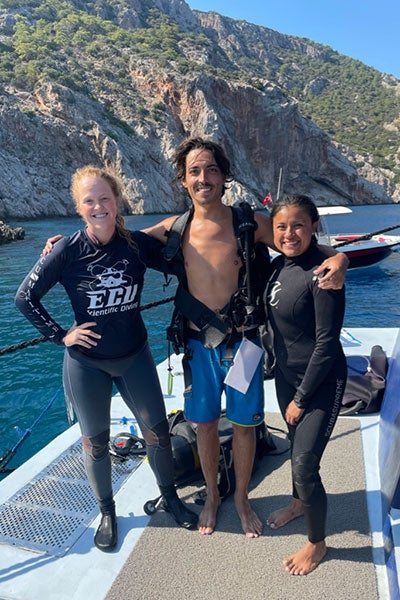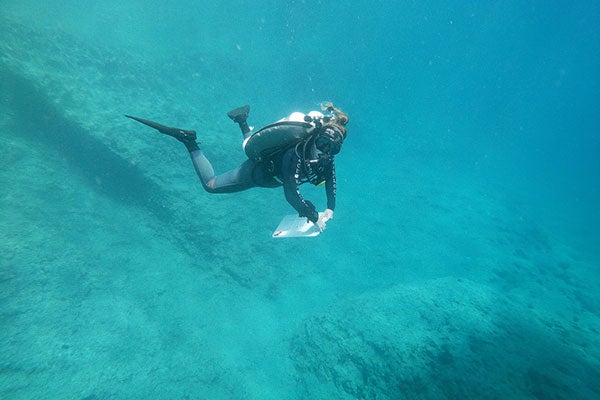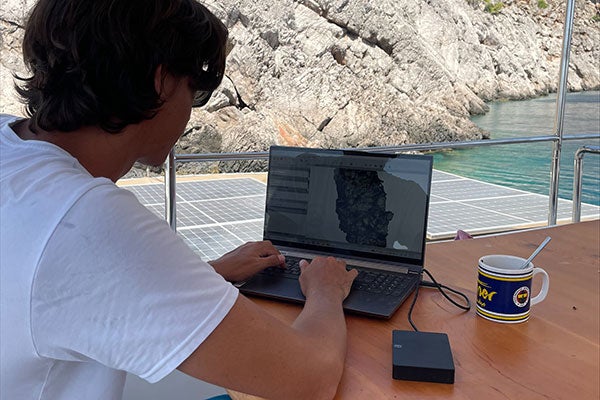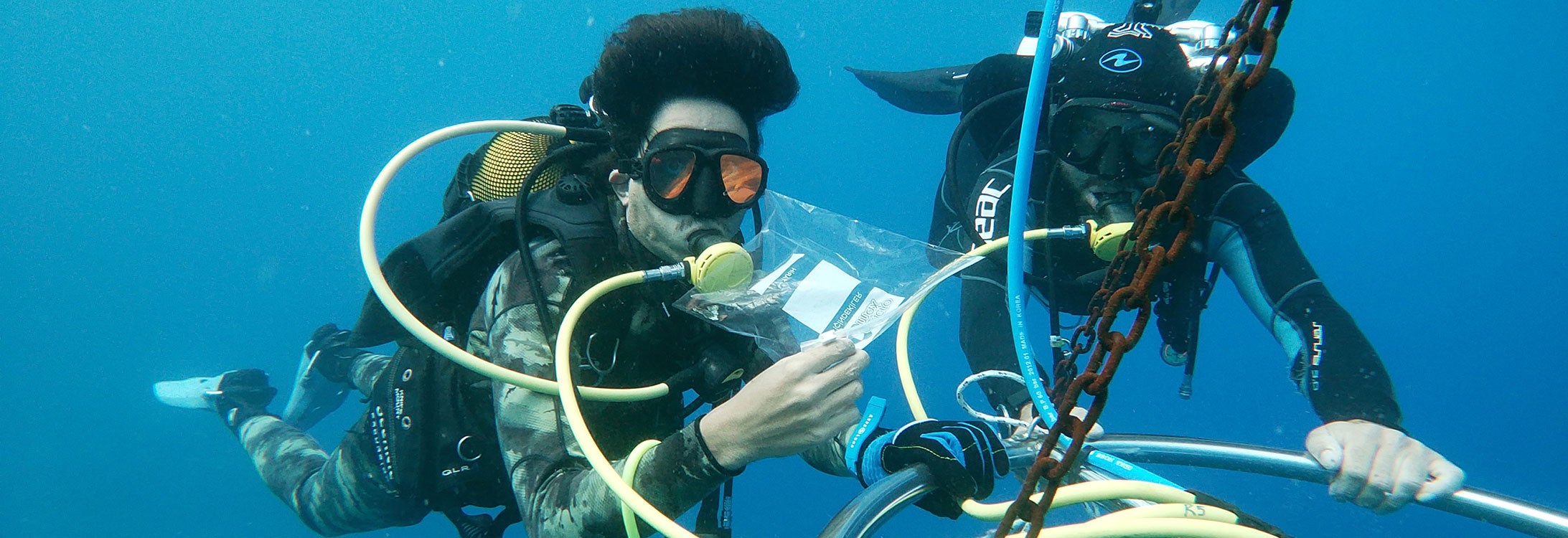OLDEST SHIPWRECK
Two ECU graduate students excavate the oldest shipwreck in the world
This summer, two East Carolina University graduate students in the Thomas Harriot College of Arts and Sciences and Integrated Coastal Programs participated in a once-in-a-lifetime experience excavating the oldest known shipwreck in the world.

ECU graduate students Lindsay Wentzel and Dominic Bush dived with fellow international researchers, including Mariana Piña, right, an underwater archaeologist for the Instituto Nacional de Antropología e Historia of Mexico. (Photo by Ross Atabey)
Lindsay Wentzel, a graduate student in the maritime studies program, housed in the Department of History, and Dominic Bush, a doctoral student in the integrated coastal sciences program, housed in the Department of Coastal Studies, were the only two Americans invited to participate in the five-week research project.
“I feel like this ongoing experience in Turkey has greatly contributed to my growth as an archaeologist. It’s given me the opportunity to study in the birthplace of maritime archaeology and work alongside a diversity of different people, cultures and methods on some incredibly exciting research,” Wentzel said.
The project is led by Dr. Hakan Öniz from Akdeniz University’s Department of Mediterranean Underwater Cultural Heritage Research, with support from Turkey’s Ministry of Culture and Tourism, and the General Directorate for Cultural Heritage and Museums.
The shipwreck was discovered off the western shores of southern Turkey’s Antalya province in 2018. The Bronze Age site, located near Cape Gelidonya, Turkey, is 125 to 170 feet in depth and is estimated to be more than 3,600 years old, dating to 1600 B.C.
According to researchers, the shipwreck, which probably belonged to a merchant vessel that sank because of hitting the shore during a storm, is one of the earliest known merchant ships. Work on the vessel began in the summer of 2019, and researchers discovered that most of the ship’s cargo appears to be pillow-shaped copper ingots.
Wentzel and Bush were initially invited to the site in the fall of 2021 because of ECU’s membership in the UNESCO UNITWIN program. They acquired their visas and were able to participate in a two-week summer survey in 2022, where they documented a few dozen wreck and artifact sites in Turkey, under the direction of Öniz and Akdeniz University.
Due to their participation in the 2022 survey, Wentzel and Bush were invited back to participate in this summer’s excavation project. They were among several international researchers who joined the Turkish team on the project.

Wentzel dives to the shipwreck to conduct research and artifact excavation, recovery and conservation. (Photo by Dominic Bush)
“The project was primarily made up of Turkish archaeologists, but the primary investigator invited a few international professionals to join the project as underwater archaeologists, including Dom and myself,” Wentzel said. “We also had two archaeologists from Mexico’s National Institute of Anthropology and History, one student from the United Kingdom and a team of four Polish archaeologists.”
“I cannot overstate how much it meant to be accepted and trusted by our Turkish colleagues. It was an honor to participate in a project with this level of historical significance,” Bush said. “The initial publications on the site suggest that it is around 3,600 years old. That means the wreck would have occurred nearly 400 years before the events of Homer’s “Iliad” and more than 800 years before the founding of Rome. To physically touch and excavate artifacts of that age was truly a surreal experience.”
The archaeological work involved underwater excavating, artifact recovery and conservation, and detailed photogrammetric studies.
“Living and working on a boat, you often feel like you’re living inside of a microcosm, which at times can have its challenges,” Wentzel said. “But I truly feel like those five weeks this summer have grown me more as a professional and a person than any other singular experience I’ve had while at ECU.”

Bush views photos of the underwater dive on a computer. (Photo by Lindsay Wentzel)
Bush said he enjoyed diving each day into some of the “most picturesque Mediterranean waters one could imagine,” and that he appreciated giving back to the project through his experience of 3D photogrammetry and site mapping.
“This helped with guiding the project and understanding how the site changed as we continued to excavate. I was even able to teach several of my colleagues the methodology, just as someone had once taught me,” Bush said. “Working with our team of Turkish and international colleagues was one of the most rewarding archaeological experiences I have ever had.”
Bush and Wentzel both credit their education at ECU for helping give them the knowledge to participate in this project.
“The maritime studies program has given me a great foundation in archaeological methods and nautical history, including how much of maritime archaeology as a discipline developed in the Mediterranean. Turkey, specifically, was the site of some of the most famous and informative underwater excavations ever. This project felt almost like I had been transported into the books I had read as a part of class. I was able to use the theories and practical knowledge I gained at ECU within a context that many archaeologists dream of, but never have the chance to experience,” Bush said.
“As one of the primary dive leaders on the project, it’s been exciting to transfer the skills I learned in ECU’s American Academy of Underwater Sciences scientific diving course, ECU’s divemaster course, and my instructor course at Rum Runner Dive Shop in Winterville, in addition to the archaeological methods learned from the maritime studies field schools,” Wentzel said. “Because of this, both Dom and I were able to bring a unique perspective to the project and contribute in a meaningful way. I’m grateful for this experience and excited for future opportunities as we continue to grow this relationship with Akdeniz University and Dr. Oniz in our professional careers.”
For more information, visit:
- 3600-year-old lead weights were unearthed in the Kumluca Bronze Age Shipwreck, one of the oldest shipwrecks in the world
- Antalya-Kumluca Bronze Age Shipwreck 2019 studies—first analyses
- A new Bronze Age shipwreck with ingots in the west of Antalya—preliminary results

Wentzel, Piña and Bush, front center, pose with fellow researchers during their excavation of the shipwreck near Cape Gelidonya, Turkey. (Photo by Captain Bericat)
MORE STORIES
MORE BLOGS
